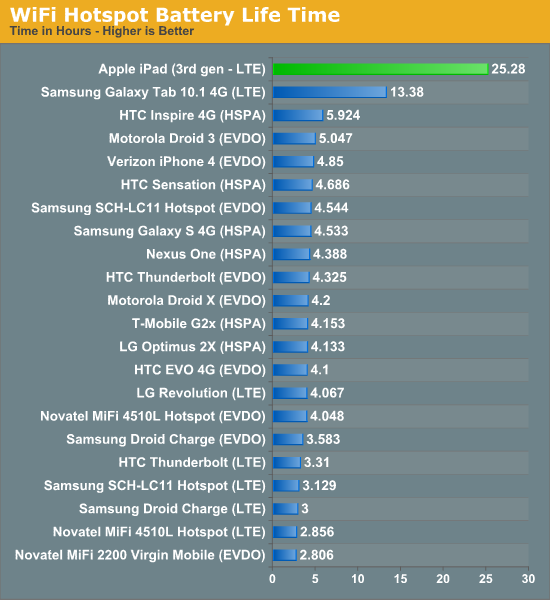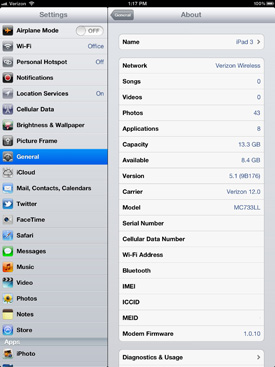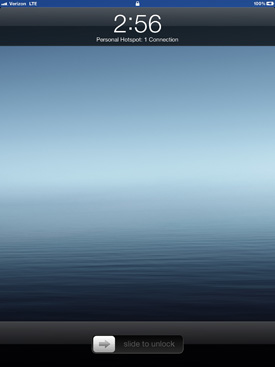The Apple iPad Review (2012)
by Vivek Gowri & Anand Lal Shimpi on March 28, 2012 3:14 PM ESTThe iPad as a Personal Hotspot: Over 25 Hours of Continuous Use
Verizon makes the decision of which iPad to buy even more difficult by being the only of the two US carriers to enable the personal hotspot option on the new iPad. For no additional monthly fee on top of your data plan your Verizon LTE iPad can act as a wireless hotspot, allowing up to five other devices to use its cellular connection over WiFi (2.4GHz only, unfortunately) or Bluetooth. One device can use the hotspot via the iPad's USB dock cable.
If you don't already have the personal hotspot option in the initial settings page, you'll need to go to general settings, then network, and activate personal hotspot there. Once you've done so you'll see a new item for personal hotspot in the default settings page.
You must remain on the personal hotspot settings page for the iPad's SSID to be visible to nearby devices. Once you leave the settings page, the iPad stops broadcasting its personal hotspot SSID.
In general the iPad's personal hotspot seems to be better behaved than similar options under Android. I've noticed all too often that Android hotspots will either stop routing traffic after an extended period of use, requiring either cycling the radio states on the hotspot device itself or in some cases a full reset of the hardware. The iPad wasn't immune to this sort of behavior, it just seemed to happen less than on the Android tablets and smartphones that I've tested. In one test it took only a few hours before I had to reset the iPad to make its hotspot work properly again, while in another case it was only after 24 hours of continuous use that the feature began misbehaving. Overall I am very pleased with the Verizon iPad as a personal hotspot, the bigger issue is the cost of the data that you're sharing with all of those devices.
As I mentioned in our Galaxy Tab 10.1 LTE review, these LTE tablets make great hotspots simply because you are pairing smartphone modems with gigantic (for a smartphone) batteries. The end result is if you have to treat your LTE tablet as a true hotspot (screen off and all), you get great battery life. The new iPad takes this idea to a completely new level since its battery is now squarely in the laptop-sized category, but its LTE modem is still designed to run on a < 6Wh smartphone battery.
Our standard hotspot battery life test involves running four copies of our web browsing battery life test and playing a 128Kbps internet radio stream on a laptop tethered via WiFi to the hotspot being tested. While peak download speeds during this test can reach as high as 1MB/s, remember that these web browsing battery life scripts include significant idle time to simulate reading a web page. The average data transferred over the duration of the test amounts to around 25KB/s if you take into account idle periods.
With the Galaxy Tab 10.1 LTE I tried something different—letting the tethered notebook download at full speed using the Tab's LTE connection. On the new iPad, after nearly an hour of downloads at well over 1MB/s I saw no drop in the battery percentage indicator—it was stuck at 100%. Not wanting to upset Verizon too much, I needed to find a good balance between a realistic workload and something that wasn't going to make me rack up over a hundred GB in overages.
If our standard hotspot test averages around 25KB/s of transfers, I figured doubling it couldn't hurt. I downloaded a sufficiently large file at a constant 50KB/s on a laptop tethered over WiFi to the new iPad to see how long it would last. The result was astounding: 25.3 hours on a single charge

I used up over 4.5GB during this period—almost the entire amount that my $50/month plan gave me, all without having to plug the iPad in to recharge it. That's the beauty of using a 42.5Wh battery to drive a cellular modem that can last a couple of hours on a tenth of that capacity. If you want to use the new iPad as a personal hotspot, you'll likely run out of data before you run out of battery life.
It's a real shame that AT&T decided against enabling personal hotspot on its version of the LTE iPad. It's for this reason alone that I'd recommend the Verizon version, assuming that you're planning on using your iPad in an area where Verizon has LTE coverage of course.












234 Comments
View All Comments
ananduser - Thursday, March 29, 2012 - link
Imagination does own the fastest GPU available today. The current Tegra offerings cannot match it but nvidia goes a different way. They will start piling CUDA cores like they do on the desktop GPU front. Say you'll have in the future a better quad core from Imagination and nvidia's GPU will consist of something like 64 CUDA cores.zorxd - Thursday, March 29, 2012 - link
The problem is that you can't plug an iDevice to a computer a transfer files as you would on a USB thumb drive without iTunes. That's a major disadvantage.Also if you excluse Apple's SoC, what company makes better mobile GPU than Nvidia? The Mali 400 MP4 is good too (about on par it seems), but I wouldn't say that Tegra 3 is the bottom of the performance barrel. You seems to forget the major players of Qualcomm and TI.
darkcrayon - Thursday, March 29, 2012 - link
You can however transfer files to any number of apps via WIFI or with cloud solutions without needing iTunes though. I'd call it a "disadvantage" but not a major one.You're right the Tegra 3 isn't, I was speaking more generally considering how the Tegra 2 performed vs. the competition as well. It just seemed out of place to choose a tablet because you "love nVidia GPUs" when nVidia has not necessarily put out a spectacular GPU in any ARM SoC.
merajaan - Wednesday, March 28, 2012 - link
You guys must be commended on this review. You covered all the areas that I wanted to know about and really didn't leave one stone unturned. I applaud the depth and detail and appreciate that you didn't rush your review out for launch day like many other sites. I also appreciate the unbiased nature in which the review was written and your honest viewpoints!Anand Lal Shimpi - Thursday, March 29, 2012 - link
Thank you for the kind words :)Take care,
Anand
repoman27 - Thursday, March 29, 2012 - link
So you've gone and included a lovely example of how the AnandTech icon looks at 72 and 144 dpi... How's about including <link rel="apple-touch-icon" sizes="144x144" href="icon144.png"/> on this site so we can have a proper icon when we add an AnandTech web clip to our home screens?adrien - Thursday, March 29, 2012 - link
Still reading the review (and liking it), I'm wondering about thermals.What was the temperature of the room? Could you try with different room temperatures? (I'm wondering how it'll change when it gets 15°C hotter and how it'll fare with sun shining on it).
Is there CPU or GPU throttling when it starts heating? Do you know the SoC temp?
Thanks. :-)
Anand Lal Shimpi - Thursday, March 29, 2012 - link
The ambient temperature in the room was approximately 23C. An overheating condition will trigger an OS-wide warning, which I believe causes the system to shut down.I unfortunately don't have access to anything that could read the SoC temp.
Testing at different room temperatures is an interesting idea but one that would be difficult to accurately control without some serious equipment. I ran these tests side by side at the same time to avoid issues with a changing ambient temperature.
Take care,
Anand
adrien - Thursday, March 29, 2012 - link
Ok, thanks. With summer approaching (and very quickly in France), I guess we'll see real-world tests for the temperature in a few weeks anyway. ;-)scribby - Thursday, March 29, 2012 - link
Nice review :)I'm also wondering about thermals,
What was the brightness level when measuring the thermals on the new ipad?
Thank you.